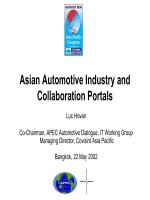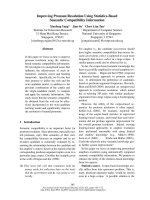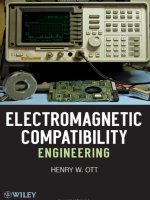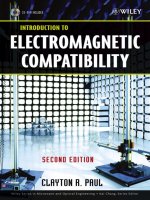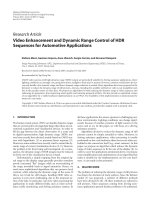automotive electromagnetic compatibility
Bạn đang xem bản rút gọn của tài liệu. Xem và tải ngay bản đầy đủ của tài liệu tại đây (11.45 MB, 310 trang )
TLFeBOOK
AUTOMOTIVE
ELECTROMAGNETIC
COMPATIBILITY (EMC)
TLFeBOOK
This page intentionally left blank
TLFeBOOK
AUTOMOTIVE
ELECTROMAGNETIC
COMPATIBILITY (EMC)
Terence Rybak
Mark Steffka
KLUWER ACADEMIC PUBLISHERS
NEW YORK, BOSTON, DORDRECHT, LONDON, MOSCOW
TLFeBOOK
eBook ISBN: 1-4020-7783-1
Print ISBN: 1-4020-7713-0
©2004 Kluwer Academic Publishers
New York, Boston, Dordrecht, London, Moscow
Print ©2004 Kluwer Academic Publishers
All rights reserved
No part of this eBook may be reproduced or transmitted in any form or by any means, electronic,
mechanical, recording, or otherwise, without written consent from the Publisher
Created in the United States of America
Visit Kluwer Online at:
and Kluwer's eBookstore at:
Dordrecht
TLFeBOOK
Contents
Preface
XI
Chapter 1 What is EMC
1.1
Background
1.2 Technology and EMC
1.3 Communication Technology Evolution
1.4 Convergence of Technology and Automotive Systems
1.5 Future Trends
1
4
7
8
10
Chapter 2 System Level Issues
2.1 Definition of Component and System
2.2 Significance to EMC
13
15
Chapter 3 Power and Signal Return
3.1 Introduction
3.2 Current Path
3.3 Safety Grounding
3.4 Single Point Ground (Single Reference)
17
19
23
24
Chapter 4 Basic Concepts Used in EMC
4.1 Antennas
4.2 Omni-Directional Antennas
4.2.1 Quarter-Wave Vertical
4.2.2 Ground Plane
4.2.3 Other Antenna Types
4.2.3.1 Antenna Arrays
4.2.3.2 Unanticipated Antennas
4.2.3.3 Reduced Size Antennas
4.2.3.4 Gain Antennas
4.3 Other components in EMC
4.3.1 Inductance
4.3.2 Inductance of “Large” Wire Loops
4.3.3 Capacitance
4.4 Ideal and Actual Components
4.5 Transmission Lines
27
32
32
33
35
35
35
36
38
41
41
43
43
43
49
TLFeBOOK
VI / Automotive EMC
4.5.1 Characteristics of Commonly Used Transmission Lines”
4.5.2 Goal of transmission line
4.5.3 Transmission line capacitance
4.5.4 Transmission line impedance
4.5.5 How to install a PL 259 connector
4.5.6 Coax Cable Sample
4.6 Shields
4.6.1 Purpose of shields
4.6.2 Shielding effectiveness
4.6.3 Key parameters in shield design (electric field)
4.7 Fourier series and Frequency Spectrum Envelope
4.8 Capacitors, Inductors, and Actual Properties
4.9 Filtering Overview
4.9.1 Common Mode Filtering
4.9.2 Isolation
4.10 Enclosure Shielding
4.11 Shield Discontinuities
Chapter 5 Electromagnetic Fields
5.1 Introduction
5.2 Characteristics of the Electromagnetic Environment
5.3 Comparison of Circuit Theory with EM Field Theory
5.4 Maxwell's equations
5.5 Regions Around a Source:
5.5.1 Far-Field
5.5.2 Transition Zone
5.5.3 Near-Field
5.6 Polarization
5.6.1 Magnetic Field Emissions
5.6.2 Modeling/Prediction Techniques
Chapter 6 EMC Testing
6.1 EMC Disciplines
6.2 Radiated Emissions Diagnostics
6.2.1 Low-Frequency Specification
6.2.2 Bulk Current Injection
6.3 How a Switching Transient Occurs
6.4 Test Methods
6.4.1 EMC Instrumentation
6.4.2 Amplifiers
6.4.3 Antennas
6.4.4 Field measurement probes
6.4.5 Power Measurement
6.4.6 RF Signal Generator
6.4.7 Electronic Impedance Bridge
6.4.8 Spectrum Analyzer
6.4.9 Monitoring Equipment
6.5 Analysis of Results
51
52
52
54
55
56
61
61
62
63
75
78
81
81
82
84
88
91
92
98
99
102
102
104
104
106
112
112
115
118
118
119
121
123
123
124
130
133
134
135
137
138
143
143
TLFeBOOK
Contents / VII
6.6 Coaxial Cables
6.7 A “Virtual” Tour of AN EMC Lab
Chapter 7 EMC Modeling
7.1 The Value of EMC Modeling
7.2 Emissions modeling
7.3 Goal of modeling
Chapter 8 Effects of Cable and Harnessing
8.1 Conducted emissions and immunity
8.2 Auto Industry EMC Approaches
8.2.1 Significance of wiring to EMC
8.2.2 Role of wiring in EMC
8.2.3 Early vehicles wiring
8.2.4 Vacuum cleaner incident
8.2.5 Common Mode and Differential Mode Current
8.2.6 RF emissions and immunity
8.2.7 Ways to measure RF current
8.2.8 Differential mode RE levels
8.2.9 DM related to design of circuit
8.2.10 Cable Shielding
8.2.11 Cable and Wiring Classes
8.3 Filter Placement
8.4 Coupling between wires
8.5 Grounding and PCB layout
8.6 Ferrites
8.6.1 Ferrite Toroids
8.6.2 Clamp-On Ferrites
8.7 Attenuating Common Mode Currents on Unshielded Cables
8.8 Higher-Frequency Emissions
Chapter 9 Automobile Electrical/Electronics Systems
9.1 Vehicle Generated Radiated Emissions
9.2 Bandwidth Relates to “Selectivity”
9.3 Broadband Noise
9.3.1 Motor Noise
9.3.2 Ignition Noise
9.3.3 SCR Noise
9.3.4 Overview of BB Noise Sources
9.4 Narrowband noise
9.4.1 Microprocessors and narrowband noise
9.4.2 Generation of narrowband interference
9.4.3 Narrowband radiate emissions case study
9.4.4 Impact of narrowband noise
9.5 Signal Characteristics
9.6 RE Differences Between “Identical” Components
9.7 Vehicle radiated emissions test
9.8 Summary
14
4
147
161
162
164
167
167
167
168
168
169
170
171
175
181
182
184
189
190
196
198
199
200
200
201
202
203
204
206
206
206
208
211
211
211
213
213
215
215
217
219
221
TLFeBOOK
VIII / Automotive EMC
9.9 Digital System Design
9.10 Electromagnetic Environment
9.11 EMC Issue: Immunity to External Fields
9.11.1 Vehicle Anti-Lock Brake System (ABS)
9.11.2 Aircraft Passenger Carry-On Devices Cases
9.11.3 F-16 Flight Controls
9.11.4 Blimp Problems
9.11.5 Boeing 747 Automatic Direction Finder (ADF)
9.11.6 Severmorsk Disaster
9.11.7 Tornado Fighter Case
9.11.8 Libyan Strike
9.11.9 Antilock Braking System (ABS)
9.11.10 Fuel System Operation
9.11.11 Aircraft
9.11.12 Medical Equipment Cases
9.11.13 Talking EEG Machine
9.11.14 Ambulance Heart Monitor/Defibrillator
9.11.15 Runaway Wheelchairs
9.12 Inexpensive shielding methods
9.13 EMC Design for Immunity
9.13.1 Component Selection
9.13.2 Logic Families and dV/dt
9.13.3 Logic Families and dI/dt
9.14 Immunity Threshold
9.15 Auto Industry “Best Practices”
9.16 Ignition Systems
9.16.1 Spark Plugs
9.16.
2
Distributors
9.16.3 Ignition Harnesses
Chapter 10 EMC Regulation of Automotive Systems
10.1 INTRODUCTION
10.2 Radiated Emissions Requirements
10.3 Governmental Requirements
10.4 FCC Part 15
10.5 “Microvolts per Meter” and Watts
Chapter 11 Vehicle System Electrical Transients
11.1 Background
11.2 Overview of the Vehicle Transient Environment
11.3 Component Selection
11.4 Logic Families and dV/dt
11.5 Logic Families and dI/dt
11.6 Load Induced Switching Transients
11.7 Specifying Control of the Switching Transient Phenomenon
11.8 Methods To Minimize The Impact Of Transients
11.9 Transient Suppression Circuit Topologies
11.1 Conclusions
221
223
226
227
227
229
230
230
230
230
230
230
231
231
231
232
232
233
233
235
236
238
239
240
241
242
242
246
247
249
249
250
250
259
263
263
264
266
266
267
270
271
272
272
TLFeBOOK
Contents / IX
Chapter 12 Electrostatic Discharge
12.1 Overview of ESD
12.2 The Role of Insulating Material in ESD
12.3 Human Body Model for ESD
12.4 ESD Voltage Breakdown
12.5 Effects of ESD
12.6 ESD Test Methods
Appendix A Acronyms and Abbreviations
Appendix B Useful Formulas
References
Index
273
275
277
27277
277
278
281
285
289
293
TLFeBOOK
This page intentionally left blank
TLFeBOOK
Prefac
e
Anyone who has operated, serviced, or designed an automobile or truck
in the last few years has most certainly noticed that the age of electronics in
our vehicles is here! Electronic components and systems are used for
everything from the traditional entertainment system to the latest in “drive
by wire”, to two-way communication and navigation. The interesting fact is
that the automotive industry has been based upon mechanical and materials
engineering for much of its history without many of the techniques of
electrical and electronic engineering. The emissions controls requirements
of the 1970’s are generally recognized as the time when electronics started to
make their way into the previous mechanically based systems and functions.
While this revolution was going on, the electronics industry developed
issues and concepts that were addressed to allow interoperation of the
systems in the presence of each other and with the external environment.
This included the study of electromagnetic compatibility, as systems and
components started to have influence upon each other just due to their
operation. EMC developed over the years, and has become a specialized
area of engineering applicable to any area of systems that included
electronics. Many well-understood aspects of EMC have been developed,
just as many aspects of automotive systems have been developed. We are
now at a point where the issues of EMC are becoming more and more
integrated into the automotive industry.
Unfortunately, the auto industry and the EMC discipline have not much
interacted with each other, except for special cases involving specific groups
or people that worked in the field. This has meant that there are vast
numbers of automotive engineers and technicians without an understanding
of EMC, and many specialized and competent EMC professionals that are
not experienced in the automotive industry.
TLFeBOOK
XII / Automotive EMC
The solution to this problem? A body of knowledge that can put, in
automotive terms, the concepts and issues in EMC. This is what the authors
of this text have attempted to do. This book is intended to be a “one-stop”
reference and introduction to the subject of automotive EMC that will enable
those working in the auto industry to be able to identify EMC issues, causes,
and corrective actions, as well as provide references for those wishing to
research the subject further.
The format of the text is intended to facilitate either an introduction to the
subject of automotive EMC or as a basis for deeper research. This is
accomplished by breaking the material into chapters that are related to
specific automotive issues, and then providing the EMC background to those
issues. The description of those chapters is:
Chapter 1 discusses the evolution of EMC and how it's emerged in
relationship to technology. It also describes some of the first issues in the
area of automotive EMC and the impact that solid-state devices have had
upon automotive EMC. There is also a description of the current issues, and
a forecast of future issues.
TLFeBOOK
Preface / XIII
Chapter 2 establishes the basis of components versus systems. There are
discussions on the importance of component level and vehicle level systems
testing, and comparisons to tests that are conducted in other industries.
The subject of “power and signal integrity” is presented in Chapter 3 as a
concept to contrast with the common approach of "power and ground". This
has been used for a long time and can be a confusing approach when trying
to work on EMC problems and issues
Within many undergraduate programs resides limited understanding of
basic antennas, transmissions lines, and passive components (inductors, and
capacitors), which causes much concern and confusion. Undergraduate
engineering programs have moved to computer engineering, with the result
that studying radio frequency components and basic items have been deleted
on the belief that they are unnecessary. These are important items to know
for any EMC study, and the material is covered in Chapter 4.
A study of EMC must include covering the fundamentals of
electromagnetic field theory and the physical laws. Maxwell's equations are
reviewed as to their applicability to EMC issues, and to provide a framework
for understanding the physics of the issues. Also included are the concepts
of near and far field’s, measurement of field strength, and propagation
characteristics. Path loss is included to provide insight into the attenuation
of signals that need to be considered in immunity issues. This material is
presented in Chapter 5.
Chapter 6 is an overview of test methods as related to vehicle-level
testing and component-level testing. While some component-level testing
methods are standard across industries, and the unique aspects of using test
equipment for vehicle level testing is discussed.
EMC modeling is a method that is evolving as a method for the future.
An overview of current tools and possible use of those tools is covered in
Chapter 7.
Chapter 8 discusses effects of cabling and harnesses used to connect
electronic modules and sensors systems (most of today’s vehicles). These
may include electronic systems for engine operation, vehicle control, or
entertainment systems and so forth. The automotive industry has addressed
compatibility issues through EMC departments designed to resolve and
address problems and develop solutions in the component design phase by
working with suppliers of those particular components in integrating them
TLFeBOOK
XIV / Automotive EMC
into the vehicle systems. In addition, the manufacturers conduct extensive
testing to verify both the component- and vehicle-level EMC performance
before a vehicle is offered for sale.
Automotive electrical and electronic systems have unique characteristics.
Some components operate on low voltages and current levels, while high
voltage and high current systems are used throughout the vehicle. These
include the ignition system, alternator and charging system, and other high
current and high-voltage devices. As we move forward into more
complicated vehicle system architectures and electronics, we will see that
EMC will become more important as an item to consider in vehicle
engineering. There is discussion in Chapter 9 of the current and future data
communication systems and networks on vehicles, with examples of EMC
issues associated with those systems.
Several standards, rules, and regulations cover the automotive industry
both from industrial and regulatory standpoints. These include the directives
and requirements of international bodies such as the European Union and the
Canadian government. In the United States, the FCC has responsibility for
the control of radiated emissions and interference for products, although the
automotive industry has some exemptions from these requirements. Chapter
10 discusses the requirements that do exist and practices that are
incorporated where requirements or regulations do not exist.
A challenge as we move forward in automotive EMC is that of
controlling and understanding the vehicle level electrical transients that
occur. Many of these effects are just now becoming more frequent, and the
difficulty is understanding the sources of these transients. Chapter 11 will
review the research and current development of quantitative methods of
defining vehicle level transients.
Electrostatic discharge is an area that also merits consideration in the
automotive system. This is because there are many devices that can be
sensitive to ESD. Chapter 12 overviews ESD, its nature, and the test
methods that are used in the automotive industry.
Is this text intended to be the first and last source of all material on
automotive system EMC? Absolutely not! It has been the author’s intention
to provide only a starting point in this subject. We’re sure that as time goes
by, others will meet the challenge of this discipline and create information
that keeps up with the auto EMC industry. It is with that anticipation that
this work is written.
TLFeBOOK
Chapter 1
What is EMC?
1.1
BACKGROUND
This book is a study of the issues, experiences, and trends in automotive
system electromagnetic compatibility (EMC). EMC and automotive systems
is an area evolving from the early days of few electrical devices to the highly
complex electronic components in vehicles. This book will look at how the
EMC of automotive systems has become a major issue, and describe the
tools and techniques of automotive systems EMC. We will look at various
system components architectures and EMC issues that are associated with
those systems.
We’ll assume the reader has a basic understanding of automotive
electrical and electronic systems. Let’s begin this book by defining EMC as
“the ability of an electronic system to function properly in its intended
electromagnetic environment, and to not contribute interference to other
systems in the environment.” The goal is to have the electronic system be
immune from the emissions of other systems, not interfere with the operation
of other systems, and not interfere with its own operation.
The basic model of EMC can be thought of as shown in Figure 1.1. Let's
assume we have device A and device B. Our goal in EMC is to have A and
B operate in the presence of each other as well as operate in the presence of
external environments. We do not want A to interfere with B nor do we
want to B to interfere with the operation of A. We also do not want to the
external environment (for example, radio broadcast transmitters) to cause
either A or B to operate incorrectly.
A key concept in EMC is the “source-path-receiver” relationship, which
is shown in Figure 1.2.
TLFeBOOK
2 / Automotive EMC
This shows that fundamentally, we have three basic elements comprising
EMC; the first is the source, the next is the path, and the final one is a
receiver. Receivers may be of two different types; “intentional” or
“unintentional.” An example of an intentional receiver would be a radio or
television receiver, and an example of an unintentional receiver would be a
computer or some type of electronic device. This is the basic model that we
use in addressing EMC problems, and one to which we always attempt to
reduce our EMC problems.
How can we ensure EMC with knowledge of this model?
We could suppress the energy at the source (meaning that we could
reduce the amount of energy being radiated).
We could address the path itself; this path might be conducted
through a wire, or radiated through the air.
TLFeBOOK
What Is EMC / 3
We could address the receiver's characteristics and make it a
“hardened” receiver.
A key issue with regard to receivers of energy is the concept of immunity
and susceptibility. In the automotive industry, we use the term immunity,
whereas most other areas that are concerned with the EMC disciplines use
the term “susceptibility”. For purpose of this book we will define
susceptibility and immunity as the related as shown in Figure 1.3. If we
move up the vertical axis, we have increasing levels of susceptibility; and if
we look to a horizontal axis and move to the right that is decreasing
immunity. What we're saying is that if we have a susceptible component or
system, we have little immunity; and something that is immune has little
susceptibility. This is not unlike the human body immune system; if we say
that we have a highly effective immune system, we are less susceptible to
illness.
TLFeBOOK
4 / Automotive EMC
1.2
TECHNOLOGY AND EMC
It is important to understand the origin and the migration of EMC issues
which have developed as a result of technological innovations during the last
century. At the beginning of the 20
th
century, the technology of the day with
regard to communications consisted primarily of generating high frequency
radio signal by generation of high-voltage discharges.
The systems were used to send short messages and allowed
experimentation with propagation characteristics and high-frequency
transmissions. Since there were few of these systems, there were few
instances of EMC.
In the late 1800’s to the early 1900’s, there was much work done with
“wireless” (the original term for radio) communication. One person heavily
involved in this work was Gugliemo Marconi. Marconi did many
experiments in Italy and was interested in how to send messages across the
airwaves. He studied the experiments that Hertz and other pioneers in the
field were performing, and he wanted to conduct such experiments himself.
His work involved sending RF energy across distances using some of the
techniques shown in Figures 1.4 and 1.5. The key elements in his
experiments were a method to create RF energy (which was accomplished
by a high voltage coil), a power source (battery), and a way to transfer the
energy to the air (plates). Today antennas accomplish this energy transfer.
He then constructed a way to receive the energy by creating a receiver
system that consisted of plates and a device that allowed the detection of the
spark energy allowing the sound to be heard in headphones. A schematic
diagram of his original system is shown in Figure 1.6. A schematic of one of
his later developments is shown in Figure 1.7.
TLFeBOOK
What Is EMC / 5
Reproduced with the permission of Marconi Corporation plc from
www.MarconiCalling.com
Reproduced with the permission of Marconi Corporation plc from
www.MarconiCalling.com
TLFeBOOK
6 / Automotive EMC
Reproduced with the permission of Marconi Corporation plc from
www.MarconiCalling.com
Reproduced with the permission of Marconi Corporation plc from
www.MarconiCalling.com
TLFeBOOK
What Is EMC / 7
1.3
COMMUNICATION TECHNOLOGY EVOLUTION
If we look at the early days of electronic communication, we see that
there was at first a revolution, caused by spark-gap technology, and there has
subsequently been evolution. The EMC issues associated with spark
technology were few because there were few receivers. Although the nature
of spark-gap transmitters would be that the signals would have a wide
bandwidth in general, people could identify which transmission they wanted
to receive. There were minimal EMC issues.
As technology evolved and there existed a need for more complex
receivers, additional components were developed. The major advance in
technology was the development of vacuum tubes. This was a major
revolution, as it finally allowed amplification of low power circuits,
impossible with passive components. Fortunately, the characteristics of
vacuum tubes are that they require large amounts of power and high-
voltages, which minimized potential EMC issues.
The next major step in the technology evolution was “solid-state” (so
called because these were solid material and did not require fragile class
envelopes and vacuums), primarily developed after WWII. The first devices
consisted of diodes and transistors, which were intended to replace the
already many applications of vacuum tubes. One characteristic of solid-state
devices has actually increased EMC issues; solid-state devices require low
energy and low voltage levels to operate. By their nature solid-state devices
operate on low-level signals, and can be affected by low-level amounts of
radio frequency energy. Of course, today’s systems include many solid-state
devices, and we've moved now to areas of high-scale integration and small
geometry with even lower energy levels required to operate those devices.
An additional item that has been developing recently is a high demand for
radio-frequency spectrum (evidenced by the number of auctions that the
FCC [Federal Communications Commission] conducts) as the demand for
wireless communications systems increases. This additional aspect has
placed an awareness of EMC because of many communications devices that
could be affected by EMC issues.
In summary, the combination of the technology evolution and the
demand for RF spectrum has created many EMC issues that exist today.
This is shown in Table 1.1: Observe the left-hand side which shows the
migration from spark to tubes to solid-state technology, and then as the
number of signals and emissions increase, the number of EMC issues
increase, with possibly no end in sight.
TLFeBOOK
8 / Automotive EMC
1.4
CONVERGENCE OF TECHNOLOGY AND
AUTOMOTIVE SYSTEMS
Why is EMC important in any automotive environment? In recent years,
automotive systems have increased their content of both electrical and
electronic devices. Electronic systems on today's vehicles include many
functions that were not incorporated on previous vehicles, or even imagined!
For example, today’s systems contain active electronics; and many
electronics modules include microprocessors, transistors, and switching
devices. These electronics provide increasingly more control functions on
vehicles. The concern is that these assemblies and components may emit
energy and will also react to external sources of energy, resulting in
unanticipated performance of these vehicle systems.
Why study EMC? There are a number reasons. The first one is to
understand how to meet various legal requirements for EMC in different
countries. For example, the European Union and Canada both have
requirements for radiated emissions. In the United States, emissions from
electronic devices are regulated by the FCC; however, what is unique about
the automotive industry is that the devices on automotive systems are
exempt from the radiated emission requirements included in “Part 15” of the
rules and regulations, provided they do not cause “harmful interference.”
Another reason might be meeting product requirements. Clearly
consumers now are very demanding regarding system and component
performance. Safety, cost of retrofitting “fixes”, and legal issues are also
incentives to ensure EMC.
TLFeBOOK
What Is EMC / 9
Today, although many of the components that were used on early
automobiles (high voltage distributors) may still be used, we now have
extensive use of digital devices on all kinds of systems including automotive
systems. You may recall from Fourier series analysis that one of the aspects
of digital devices (which operate at square waves) is that a square wave
contains many harmonics. These harmonics are based upon the (10-90
percent) rise time and the fall time of the square wave signal as shown in
Figures 1.8 and 1.9. We will discuss later in detail the EMC challenges of
these.
As shown in Figure 1.9, we have a frequency content in the rise and fall
edges that is much greater than the fundamental frequency, and a frequency
content of zero in the areas where the signal is at a level value. Digital
devices are used on many systems today and we will use more in future
applications. This is one of the major sources of EMC (specifically
emissions) that we experience in today’s automotive industry.
TLFeBOOK
10 / Automotive EMC
1.5
FUTURE TRENDS
The importance of EMC to product design and manufacturing will probably
increse due to a number of reasons.
TLFeBOOK
